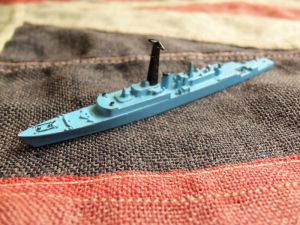HMS Volage M 790 Triang Minic Ships 1959-64
Price: NZ$28.80
Code: BH332
HMS Volage M 790 Triang Minic Ships 1959-64
HMS Volage one of the Royal Navy’s five ship “V” Class 1st Rate Fast Anti-Submarine Frigates which were conversions of the remaining ships from the eight ship flotilla of “Valentine” Class destroyers that were laid down, built and commissioned during the Second World War.
The “Valentine” Class comprised HMS Valentine, HMS Vixen, HMS Vigilant, HMS Venus, HMS Virago, HMS Volage, HMS Verulam, and the Flotilla Leader HMS Hardy which was lost in battle during the Second World War. HMS Valentine and HMS Vixen were transferred to the Royal Canadian Navy in 1944 as HMCS Algonquin and HMCS Sioux respectively.
HMS Volage was converted in the 1950’s during which her armament was reduced from the original four 4.7” main guns forward, four 40 mm Bofors, four 20 mm anti-aircraft guns and eight 21” torpedo tubes to two 4” guns aft, two 40 mm Bofors abaft the bridge, and 2 Squid triple barrel depth charge mortars at the stern.
Tri-ang Minic produced models of four “V” Class frigates HMS Vigilant, HMS Venus, HMS Virago and HMS Volage. The models of HMS Vigilant and HMS Venus differ from those of HMS Virago and HMS Volage in the shape of the bridge and the absence of the 40 mm Bofors anti-aircraft mount abaft the bridge. Otherwise the models are distinguished only by the model number and name marked on the underside.
In good playworn original finish, minimal chipping , with mast, very good condition for its age. Unboxed model.
We have a very large collection of minic pieces to list if you are looking for anything in particular please email through the contact page on this site.
This section of the shop is about the amazing original series of diecast metal ships and harbour playset accessories, produced under the Tri-ang Minic Ships name in England between 1959 and 1964. As well as the later series of models produced under the Hornby Minic name during the early 1970’s.
The “TRI-ANG” trade mark itself resulted from a play on the truism “three lines make a triangle” the “three lines” in question being the brothers William, Walter and Arthur Lines who founded Lines Bros Limited just after the First World War.
The Tri-ang Minic Ships name comes from the original manufacturer Minic Limited a subsidiary of Lines Bros Limited, owners of the famous “TRI-ANG” trade mark.
The models were produced by Lines Bros Ltd’s Tri-ang Works at Mordon Road, Merton, London SW19 with production moving to Minic Limited at Market Way, Canterbury, Kent during mid 1960.
The original range of ships and harbour accessories are waterline models manufactured to a scale of 1:1200 scale, where one inch is equivalent to 100 feet, the same scale that was used in the manufacture of ship recognition models for training Allied naval and airforce personnel during both the First and Second World Wars.
When Lines Bros Ltd was broken up in the late 1960’s the “TRI-ANG” trade mark remained with Tri-ang Pedigree, another Line Bros subsidiary which was also active in New Zealand and Australia, while the “MINIC” trade mark was transferred to Hornby together with the tooling for the Minic Ships models.
All of the models produced under the Hornby Minic name were produced in Hong Kong after Hornby moved their manufacturing in the early 1970’s. Hornby produced only a limited selection of the original models but also introduced four new models of famous battleships – USS Missouri, IJN Yamato, DKM Bismarck and DKM Scharnhorst.All of the ship models produced under the Hornby Minic name were fitted with a red plastic base equipped with plastic rollers.
The original Tri-ang Minic and Hornby Minic series of models are no longer in production and to the best of our knowledge the tooling for these models no longer exists. So the original models have become quite collectable as they were only made for 6 years and being mainly children’s toys, many sadly have not survived. What has is in various states of repair! Still they are an incredible early 1960’s toy which can be arranged in attractive displays, and enjoyed in many homes or businesses where a nautical theme is desired



